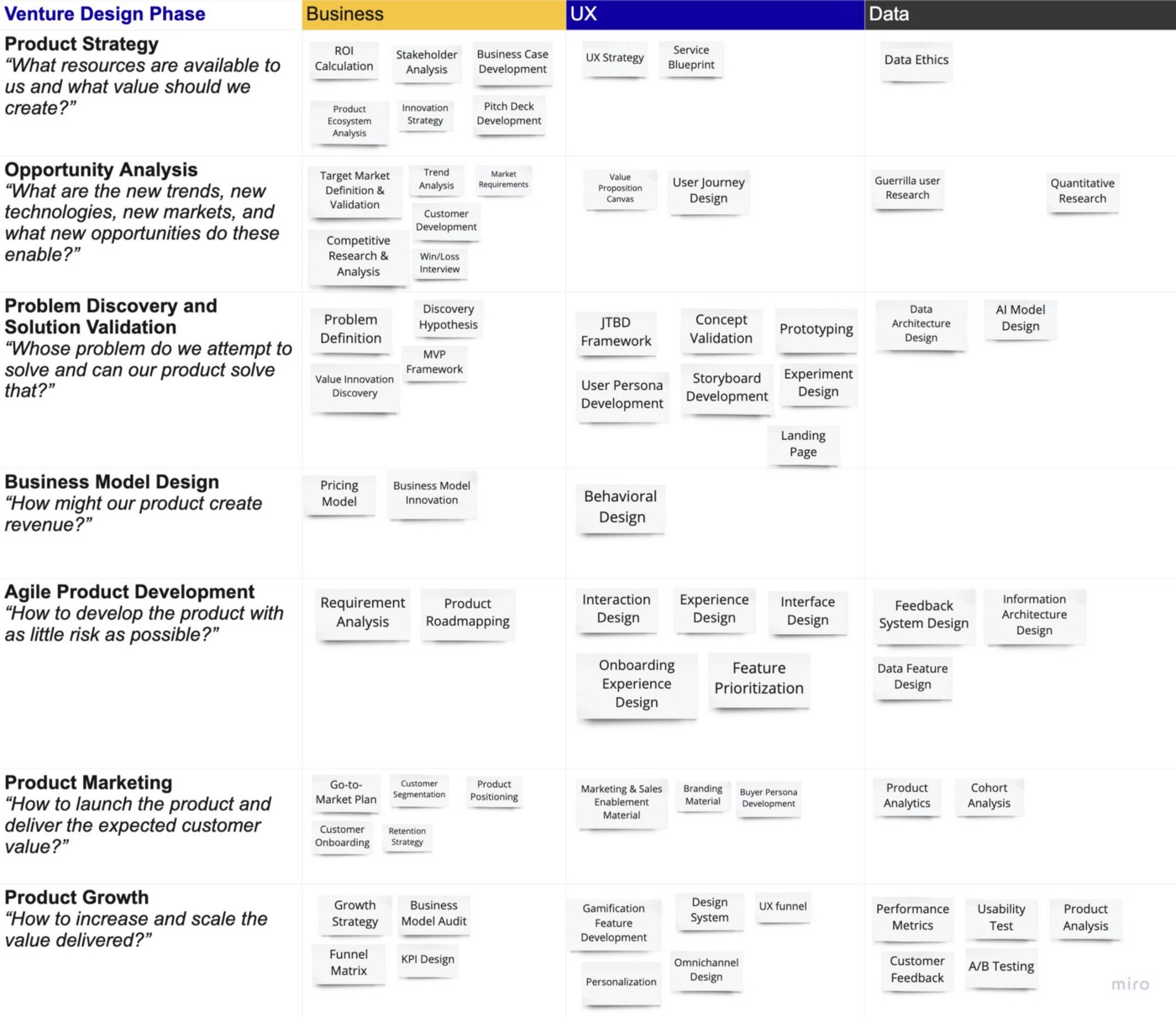For the past 4 years building venture products, I picked up skills that I didn’t expect to. These skills were sporadic and incoherent at the beginning. Learning them seemed to be a reaction to a situation — a need to solve a problem. It wasn’t clear to me if and how these skills were relevant to my role until I repeated the venture development cycle many times and found a pattern.
So I created a venture design framework to summarizethe skills needed at different phases of the venture development process. I hope this can help you understand the venture designer’s role, and make a pointed investment in growing relevant skills if you want to become one.
Review Venture Design
As mentioned in the first article,
Venture design is a human-centered, agile approach to develop an idea into a product through the venture development process with the goal to minimize business risks.
The venture development process starts with an idea and ends with a launched product with defined business value. This process can be roughly dissected into 7 phases. A venture designer participates in all of them.
Venture Designer’s Role
The venture designer’s jobs-to-be-done is to identify constraints, manage 3 major types of risks, and find the local maxima of desirability at different phases of the venture development process.
The total value delivered, usually in form of a Minimum Viable Product, is venture designers’ ultimate deliverable. An MVP might not be “desirable” upon launch, but it has to deliver positive value to the product consumers, as well as the business.
Product/Market fit is the venture team’s goal. It cannot be achieved without an MVP. It might sound contradictory, but venture designers are ready to sacrifice UX for better allocation of resources to accelerate product launch.
Venture Designer vs. UX Designer
Similar to UX designers, venture designers are experts on minimizing desirability risks. Unlike UX designers, venture designers’ job is not to optimize UX at all times but to maximize the total value delivered within constraints in a highly uncertain environment.
That’s why venture designers usually have a “wider” set of skills compared to traditional UX designers.
Venture Design Framework
The venture design framework summarizes the venture design skills needed at different phases of the venture development process to launch an MVP. It has 7 phases and 3 pillars.
7 Phases
The venture development process is divided into 7 phases based on the 7 unique problems that need to be solved by the venture team in chronological order.

3 Pillars
A product is valuable to a business if it generates revenue or reduces cost. It is valuable to users if it creates gains and reduces pains in user experience. Data creates value when it’s designed to support one of the above, and data is the fuel of the most important technology in this age — the Age of Artificial Intelligence.
That’s why business, UX, and data are the 3 most valuable capabilities for a venture designer.

Venture Design Framework (w/ Example Activities)
Activities I perform include but are not limited to what’s listed in the framework below.

Venture designers work with developers, subject matter experts, business analysts, and stakeholders to reduce desirability, viability, and feasibility risks at the same time. An MVP can only be successful if team members learn from each other and grow together.
The more you are capable of doing, the more valuable you are as a venture designer. As you gain more project experience, you will grow skills in all 3 pillars naturally.

Are You a Venture Designer?
If you are excited about the way venture designers work, I highly suggest you give it a try! There is no lack of opportunity to get involved in a startup or a venture project as long as you are passionate about inventing and are willing to take the risk.
On the other hand, if you feel overwhelmed by the uncertainty and the variety of activities mentioned, the venture designer role might not be a good fit for you.
Keep in mind that I didn’t join the practice knowing I might need to know all these skills one day (certainly not on day one!) However, I did find tremendous joy connecting the dots, which I wouldn’t know if I didn’t choose to embark on this journey.
Lastly…
At the end of the day, it doesn’t matter what your title is.
Don’t try to define your role. Instead, define your impact, then grow skills to deliver it.
I hope you learned more about yourself and the role of venture designer from this article. Best wishes to you for finding a fulfilling role. See you in my next post.





